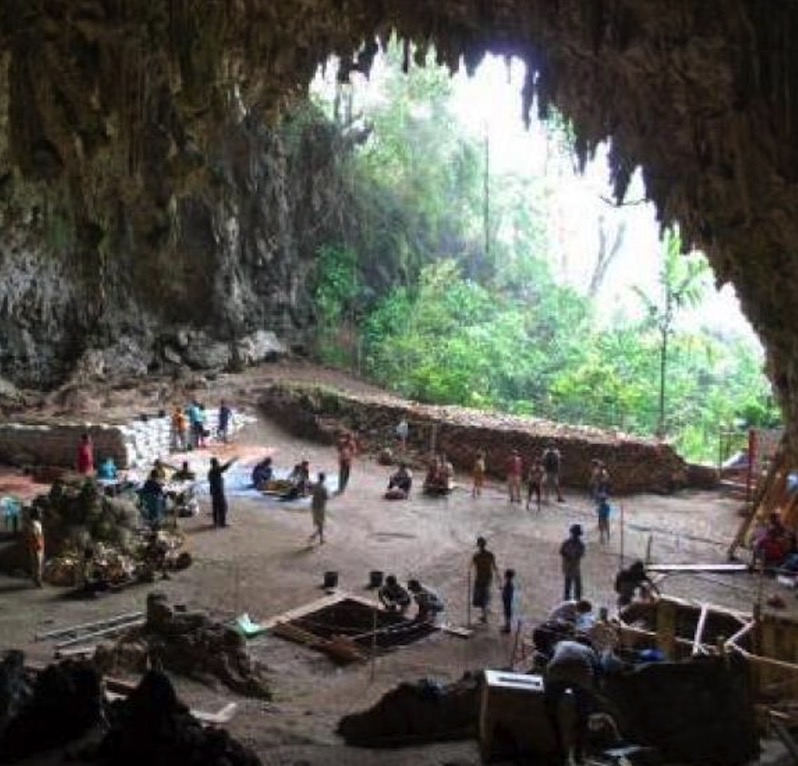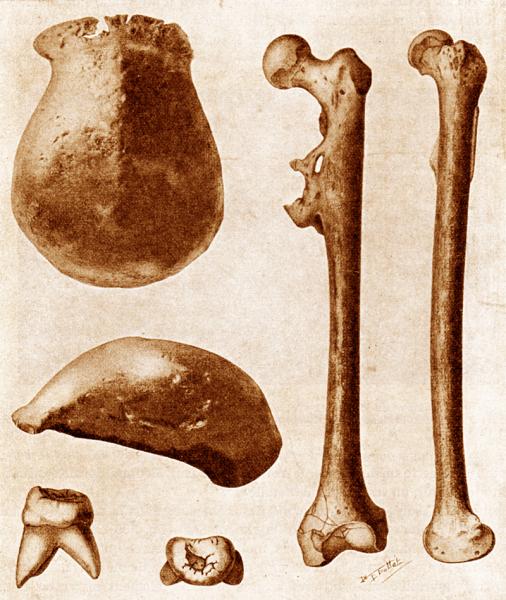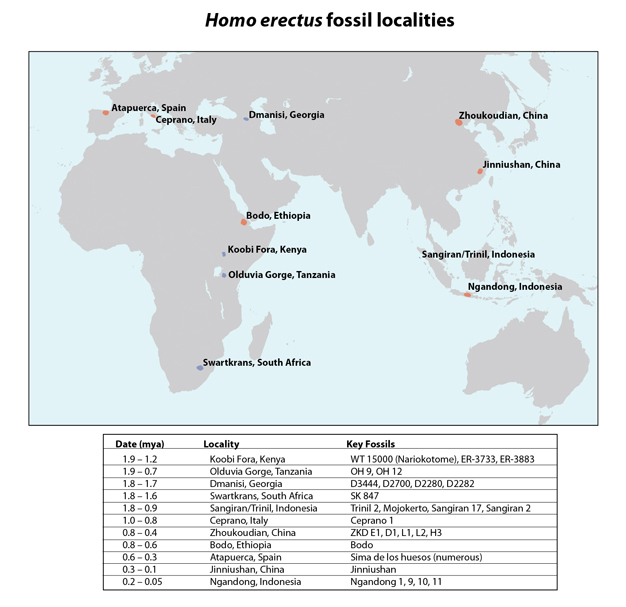1887: First discovery (Java Man)
In the late 19th century, scientists speculated that the most ancient humans would be found in tropical regions of East Asia. In 1887, Eugene Dubois, a Dutch anatomist who held this view, was posted to Indonesia as a military doctor. This job allowed him time to search for early human fossils. First excavating in caves on the island of Sumatra, he found a hominid jaw fragment in 1890. Later, he moved on to Java. Around 1891-1892, he recovered a Homo Erectus brain case and femur in the Solo river valley. These remains were estimated to be about 700,000 years old, and returning to the Netherlands with his fossils in 1895, Dubois proclaimed them to be our earliest found ancestor. He had named his discovery
Pithecanthropus erectus; but the press preferred the name
Java Man. [ Ref:
Palomar College,
Trinil Site or
Ref2 ]
1921: Zhoukoudian (China):
In 1921, remains similar to Java Man are discovered just north of Beijing.
Thereafter, the "Peking Man" site will be investigated by multinational teams of archeologists
until the start of WW2. It has yielded the largest collection of hominin bones ever found at one site:
six skulls, and hundreds of fragmentary remains from about 40 early humans
(Homo erectus) who lived between 750,000 and 400,000 years ago. [
Hominins in China ]
1930s: Solo river valley (Java):
In the 1930s, major exploration started at
Sangiran , near the site of the original Java Man discovery.
The first partial cranium of H. erectus (Sangiran 2) was discovered in 1937, with Sangiran 4 (partial cranium with palate and most of the maxillary teeth) found in 1939. The most complete specimen so far discovered is Sangiran 17
Site has yielded remains of over than 100 individuals of Homo erectus, dating back to at least 1.5 million years ago. These fossils show human evolution process during the Pleistocene period, particularly from 1.5 to 0.4 million years ago.
Later Discoveries
1960s: Leakey et al. (East Africa)
It was only after 1960, that field work by Louis Leakey and others in East Africa established
Africa as the true spawning ground for successive hominin species. [Ref:
Smithsonian, also
Facts&Details ].
- Initially, the Leakeys found trace of the older Homo habilis in the Rift Valley; then, Erectus remains dating back to 1.4 Mya were uncovered at Olduvai Gorge in Tanzania; and even older remains were found, by others, in Ethiopia (2.3 Mya).
- In addition, Turkana Boy, a nearly complete skeleton dating back 1.9 Mya, was found in northern Kenya and a skull dated to 1.95 Mya uncovered in South Africa.
-
What really moved the human origins spotlight to East Africa was the ability to accurately pin an age on the bones the Leakeys and others were uncovering. While the fossils could not be dated directly, volcanic ash layers interspersed between the artefacts, could be dated by the clocklike decay of their radioactive elements.
Yuanmou Man is the earliest fossil evidence of humans in China.
The remains, estimated to be roughly 1.7 million years old, were found in the Yunnan Province of southwestern China; and consist of two upper first incisors presumed to have belonged to a male, and a partial tibia presumed to have belonged to a female. The female may have stood about 125–130 cm (4 ft 1 in–4 ft 3 in) in life. These remains are anatomically quite similar to those contemporary early Homo in Africa, namely H. habilis and H. ergaster.
1983: Spain ( Atapuerca & Orce )
Massive evidence of early hominin presence in Europe comes from sites in the
Atapuerca region (Northern Spain) [
Wikipedia ] as well as
Orce in Andalusia [
Wikipedia ]
First, in 1983, at the Sima de los Huesos ("Pit of Bones") site, excavators found the remains of 30 hominins dated to about 400,000 years old. The remains have been tentatively classified as Homo heidelbergensis and may be ancestors of the Neanderthals.
In 1994, the cave of Gran Dolina, nearby, yielded earlier specimens; six hominin skeletons, dated between 780,000 and 1.2 million years ago. Experts have debated whether these skeletons belong to the species Homo erectus, Homo heidelbergensis, or a new species called Homo antecessor.
Orce: (2013) a child’s tooth reliably dated to be 1.4 million years old was uncovered after decades
of exploration in Europe's richest sites for prehistoric fossils and stone tools
[ Europe's First Settlers (BBC) , U. Chicago].
Digs had started in 1976, uncovering thousands of 1.2 Mya old tools and fossils, including: saber-toothed tigers, hippos, horses, deer, mammoths and rhinoceroses as well as evidence of early hominin scavenging; but,
frustratingly, for over 40 years, no certifiably hominin remains had been found.
This becomes the earliest evidence of Homo presence in Western Europe: 1.4 Mya
1991: Dmanisi, (Caucasus)
Here, 5 skulls dated reliably to 1.8-1.85 million years old were discovered alongside remains
of multiple carnivores. One skull in particular, is the world’s first completely preserved
adult hominid skull from the early Pleistocene. Another skull, that of a toothless old man,
indicates advanced social behaviour: younger active members taking care of an elder.
The most interesting aspect of the find was that individuals combined features previously
considered characteristic of different species.
[
Science (2016),
Video (15 min),
Long Video ]
References:
 Facts & Details
Facts & Details

 Facts & Details
Facts & Details

